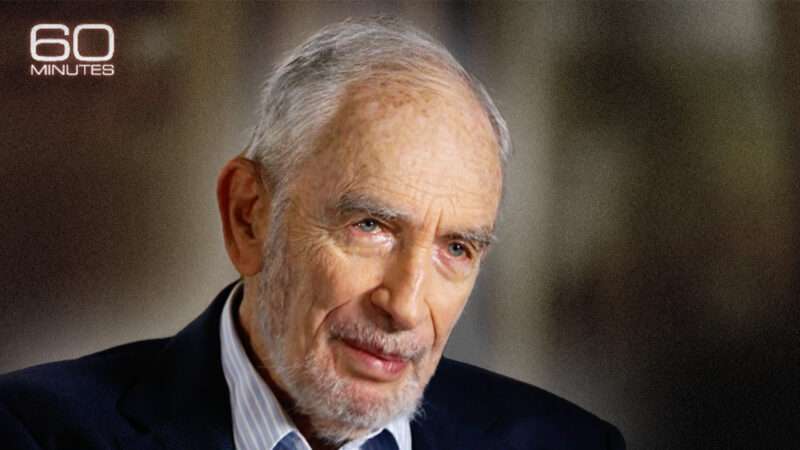
Stanford University biologist and perennially wrong doomster Paul Ehrlich appeared on CBS 60 Minutes on Sunday where he once again declared, "I and the vast majority of my colleagues think we've had it; that the next few decades will be the end of the kind of civilization we're used to."
Ehrlich made himself (in)famous when he in his 1968 bestseller The Population Bomb: predicted that "The battle to feed all of humanity is over. In the 1970's the world will undergo famines-hundreds of millions of people are going to starve to death in spite of any crash programs embarked upon now. At this late date nothing can prevent a substantial increase in the world death rate." Instead of rising as Ehrlich predicted, the global crude death per 1,000 people has fallen from 12.5 in 1968 to 7 in 2019 before ticking up to 8 in the pandemic year of 2020.
At least CBS correspondent Scott Pelley acknowledged, "The alarm Ehrlich sounded in '68 warned that overpopulation would trigger widespread famine. He was wrong about that. The green revolution fed the world." Nevertheless, Pelley credulously reports Ehrlich's assertion that the world is undergoing a Sixth Mass Extinction owing to humanity's rising population and consumption. Paleontologists have identified five previous mass extinction events during the past 450 million years in which something like three-quarters of species disappeared due to events like supervolcano eruptions and asteroid strikes.
In fact, just as positive trends in global agricultural productivity that were already underway 50 years ago nullified Ehrlich's prophecy of inevitable famines that would kill hundreds of millions, current trends in agricultural productivity, population, urbanization, and dematerialization will likely negate his extinction auguries and predictions of civilizational collapse. Why? Because an increasingly wealthy and technologically adept humanity will be withdrawing from nature over the course of this century.
As the result of continuing increases in crop productivity, the world has reached peak agricultural land which means that more land will be freed up to revert to nature as the century evolves. In addition, global human population will likely peak around 2050 and begin falling. Furthermore, people will be depopulating the landscape as they move into cities. Currently, some 56 percent of humanity live in cities and that number is projected to increase to 68 percent by 2050 and 85 percent by 2100. What that means is that the number of people living on the landscape (many as subsistence farmers) will drop from 3.5 billion now to around 1.2 billion by 2100. Again, this will free up land into which wild species can expand and grow.
In his 2020 article on resource production and use, International Institute for Applied Systems Analysis researcher Arnulf Grübler outlines a scenario in which technological progress enables a richer humanity to cut its overall natural resource use from about 100 gigatons per year now to 83 gigatons by 2050. (It's worth noting that about half of the current resource use involves non-metallic minerals, e.g., cement, sand, and stone.) Humanity can withdraw increasingly from nature by getting more and more value from ever less resource use.
Human activities have indeed been putting greater pressure on other species, both on land and in the seas. "The data are rock solid. I don't think you'll find a scientist that will say we're not in an extinction crisis," asserted Ehrlich's Stanford colleague biologist Anthony Barnosky in the 60 Minutes segment. "It means you look out your window, and three quarters of what you think ought to be there is no longer there. That's what mass extinction looks like." Assuming Barnosky's estimates are right, just how long would it take for three-quarters of the world's species to go extinct? "If currently threatened species—those officially classed as critically endangered, endangered and vulnerable—actually went extinct, and that rate of extinction continued, the sixth mass extinction could arrive within as little as three to 22 centuries," said Barnosky in the U.K. Mirror back in 2011. Three centuries is slow in terms of global geological and biological processes, but it is really fast in terms of the earlier noted positive human technological, economic, and social progress trends.
In 2018, in their article in the journal BioScience, three researchers from the Wildlife Conservation Society see biodiversity conservation reaching "breakthrough" after passing through a "bottleneck" over the next few decades. Ultimately, they projected that over the course of this century increasing wealth and urbanization will enable the global restoration of wild nature. From the article:
For the first time in the Anthropocene, the global demographic and economic trends that have resulted in unprecedented destruction of the environment are now creating the necessary conditions for a possible renaissance of nature. Drawing reasonable inferences from current patterns, we can predict that 100 years from now, the Earth could be inhabited by between 6 and 8 billion people, with very few remaining in extreme poverty, most living in towns and cities, and nearly all participating in a technologically driven, interconnected market economy. Building on the scholarship of others in demography, economics, sociology, and conservation biology, here, we articulate a theory of social–environmental change that describes the simultaneous and interacting effects of urban lifestyles on fertility, poverty alleviation, and ideation. By recognizing the shifting dynamics of these macrodrivers, conservation practice has the potential to transform itself from a discipline managing declines ("bottleneck") to a transformative movement of recovery ("breakthrough")
CBS and 60 Minutes should be ashamed of promoting Ehrlich's oft-debunked nonsense.
Note: I have debunked Ehrlich's bogus prophecies many, many, many, many times. For more background, see my books The End of Doom: Environmental Renewal in the 21st Century and Ten Global Trends Every Smart Person Should Know: And Many Others You Will Find Interesting, with my co-author Marian Tupy.
The post <em>60 Minutes</em> Promotes Paul Ehrlich's Failed Doomsaying One More Time appeared first on Reason.com.







